Analyzing Health and Illness Narratives in Nursing Practice
VerifiedAdded on 2020/03/04
|8
|2232
|287
Essay
AI Summary
This essay delves into the crucial role of health and illness narratives in healthcare, particularly within the context of nursing practice. It emphasizes how nurses utilize patient narratives to gain a deeper understanding of their clients, including their historical, familial, and social backgrounds, thereby facilitating the development of holistic care plans. The essay highlights the significance of illness narratives as culturally congruent methods for understanding patient experiences, offering more comprehensive insights compared to traditional assessment methods. It explores the influence of sociological and cultural factors on patient narratives, emphasizing how these factors shape their expressions and experiences of illness. The essay also discusses the biopsychosocial model of care, underscoring the importance of considering psychological and social contexts alongside physical health. Furthermore, it illustrates how nurses can leverage patient narratives to gather crucial cues, assess health literacy levels, and tailor intervention plans that respect patient autonomy and dignity. The essay concludes by underscoring the positive impacts of narratives in improving patient outcomes.
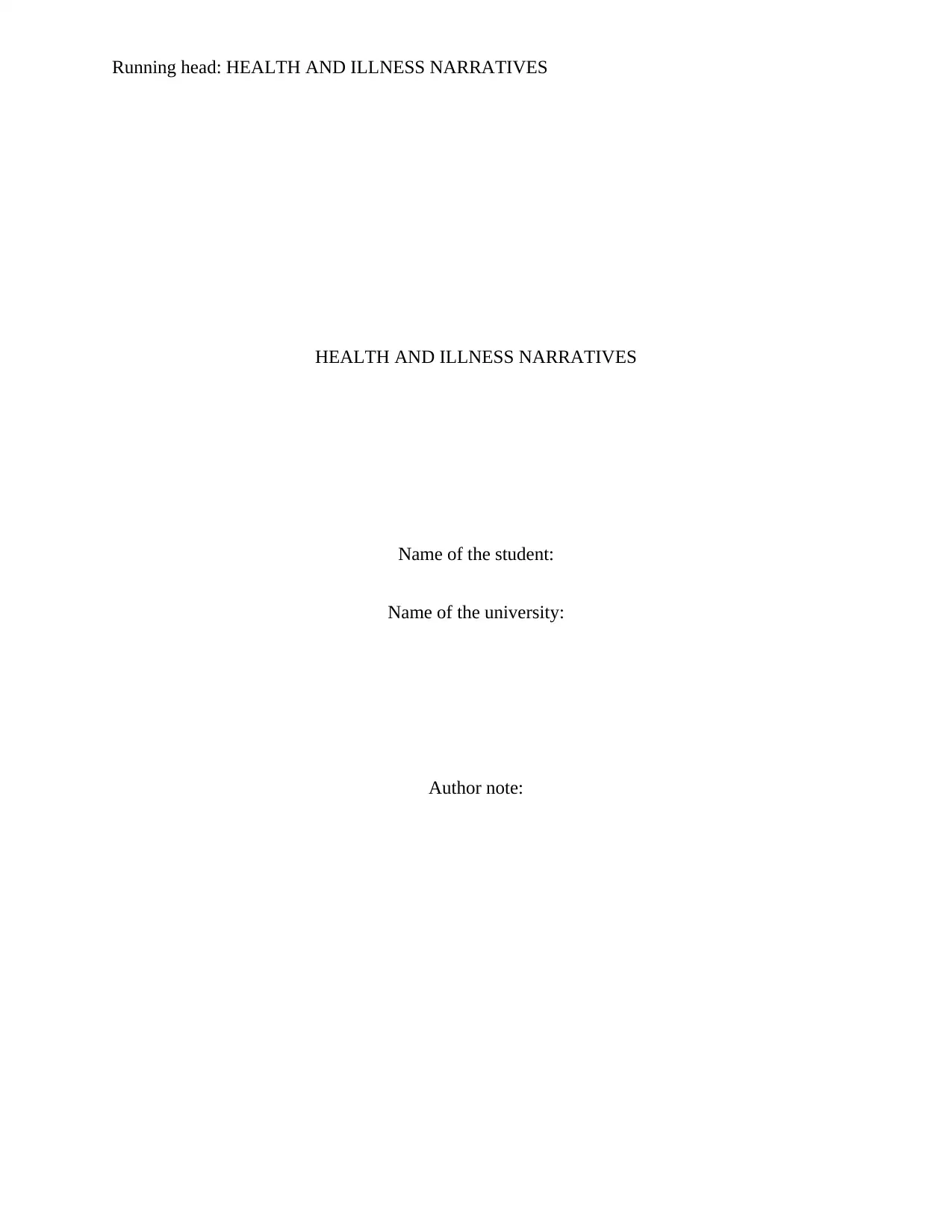
Running head: HEALTH AND ILLNESS NARRATIVES
HEALTH AND ILLNESS NARRATIVES
Name of the student:
Name of the university:
Author note:
HEALTH AND ILLNESS NARRATIVES
Name of the student:
Name of the university:
Author note:
Paraphrase This Document
Need a fresh take? Get an instant paraphrase of this document with our AI Paraphraser
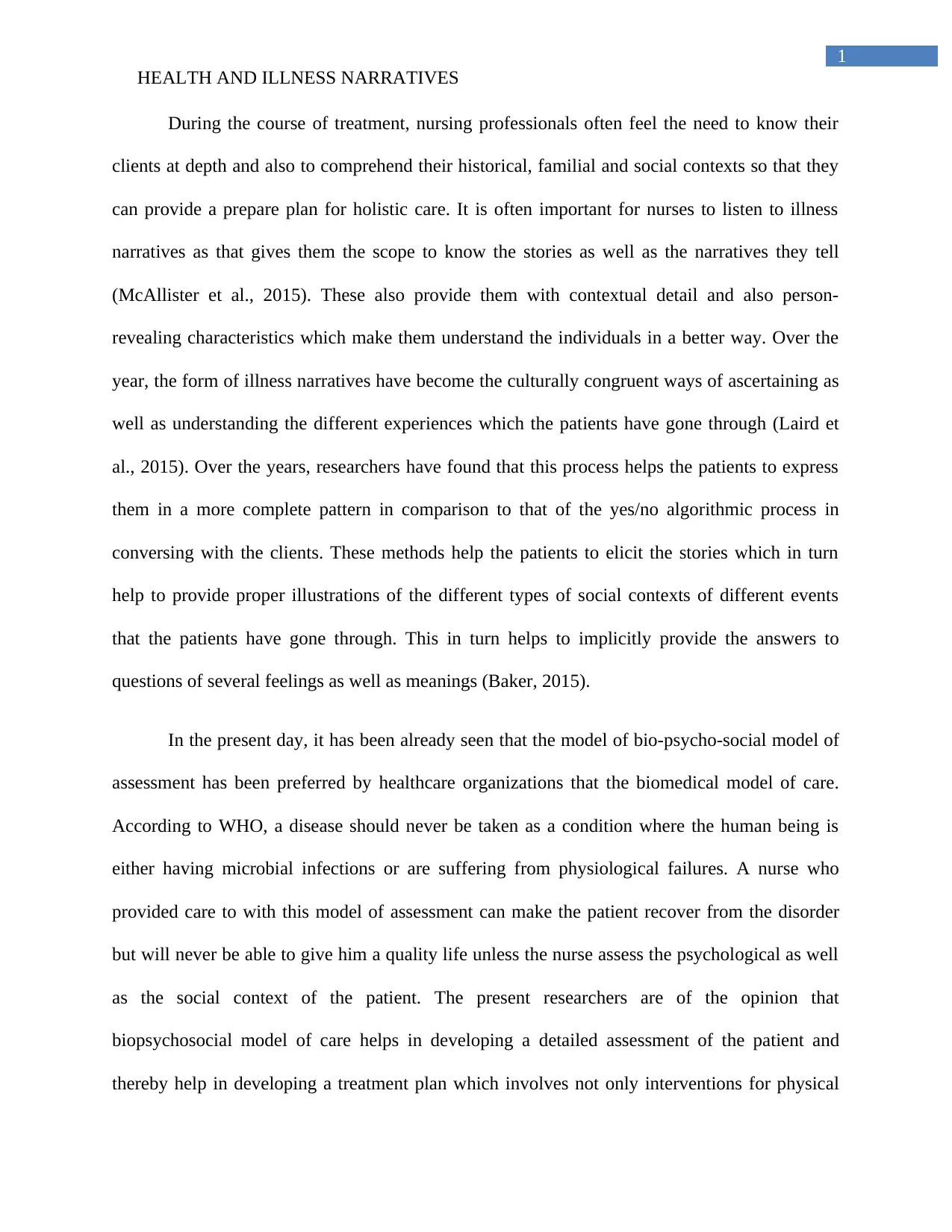
1
HEALTH AND ILLNESS NARRATIVES
During the course of treatment, nursing professionals often feel the need to know their
clients at depth and also to comprehend their historical, familial and social contexts so that they
can provide a prepare plan for holistic care. It is often important for nurses to listen to illness
narratives as that gives them the scope to know the stories as well as the narratives they tell
(McAllister et al., 2015). These also provide them with contextual detail and also person-
revealing characteristics which make them understand the individuals in a better way. Over the
year, the form of illness narratives have become the culturally congruent ways of ascertaining as
well as understanding the different experiences which the patients have gone through (Laird et
al., 2015). Over the years, researchers have found that this process helps the patients to express
them in a more complete pattern in comparison to that of the yes/no algorithmic process in
conversing with the clients. These methods help the patients to elicit the stories which in turn
help to provide proper illustrations of the different types of social contexts of different events
that the patients have gone through. This in turn helps to implicitly provide the answers to
questions of several feelings as well as meanings (Baker, 2015).
In the present day, it has been already seen that the model of bio-psycho-social model of
assessment has been preferred by healthcare organizations that the biomedical model of care.
According to WHO, a disease should never be taken as a condition where the human being is
either having microbial infections or are suffering from physiological failures. A nurse who
provided care to with this model of assessment can make the patient recover from the disorder
but will never be able to give him a quality life unless the nurse assess the psychological as well
as the social context of the patient. The present researchers are of the opinion that
biopsychosocial model of care helps in developing a detailed assessment of the patient and
thereby help in developing a treatment plan which involves not only interventions for physical
HEALTH AND ILLNESS NARRATIVES
During the course of treatment, nursing professionals often feel the need to know their
clients at depth and also to comprehend their historical, familial and social contexts so that they
can provide a prepare plan for holistic care. It is often important for nurses to listen to illness
narratives as that gives them the scope to know the stories as well as the narratives they tell
(McAllister et al., 2015). These also provide them with contextual detail and also person-
revealing characteristics which make them understand the individuals in a better way. Over the
year, the form of illness narratives have become the culturally congruent ways of ascertaining as
well as understanding the different experiences which the patients have gone through (Laird et
al., 2015). Over the years, researchers have found that this process helps the patients to express
them in a more complete pattern in comparison to that of the yes/no algorithmic process in
conversing with the clients. These methods help the patients to elicit the stories which in turn
help to provide proper illustrations of the different types of social contexts of different events
that the patients have gone through. This in turn helps to implicitly provide the answers to
questions of several feelings as well as meanings (Baker, 2015).
In the present day, it has been already seen that the model of bio-psycho-social model of
assessment has been preferred by healthcare organizations that the biomedical model of care.
According to WHO, a disease should never be taken as a condition where the human being is
either having microbial infections or are suffering from physiological failures. A nurse who
provided care to with this model of assessment can make the patient recover from the disorder
but will never be able to give him a quality life unless the nurse assess the psychological as well
as the social context of the patient. The present researchers are of the opinion that
biopsychosocial model of care helps in developing a detailed assessment of the patient and
thereby help in developing a treatment plan which involves not only interventions for physical
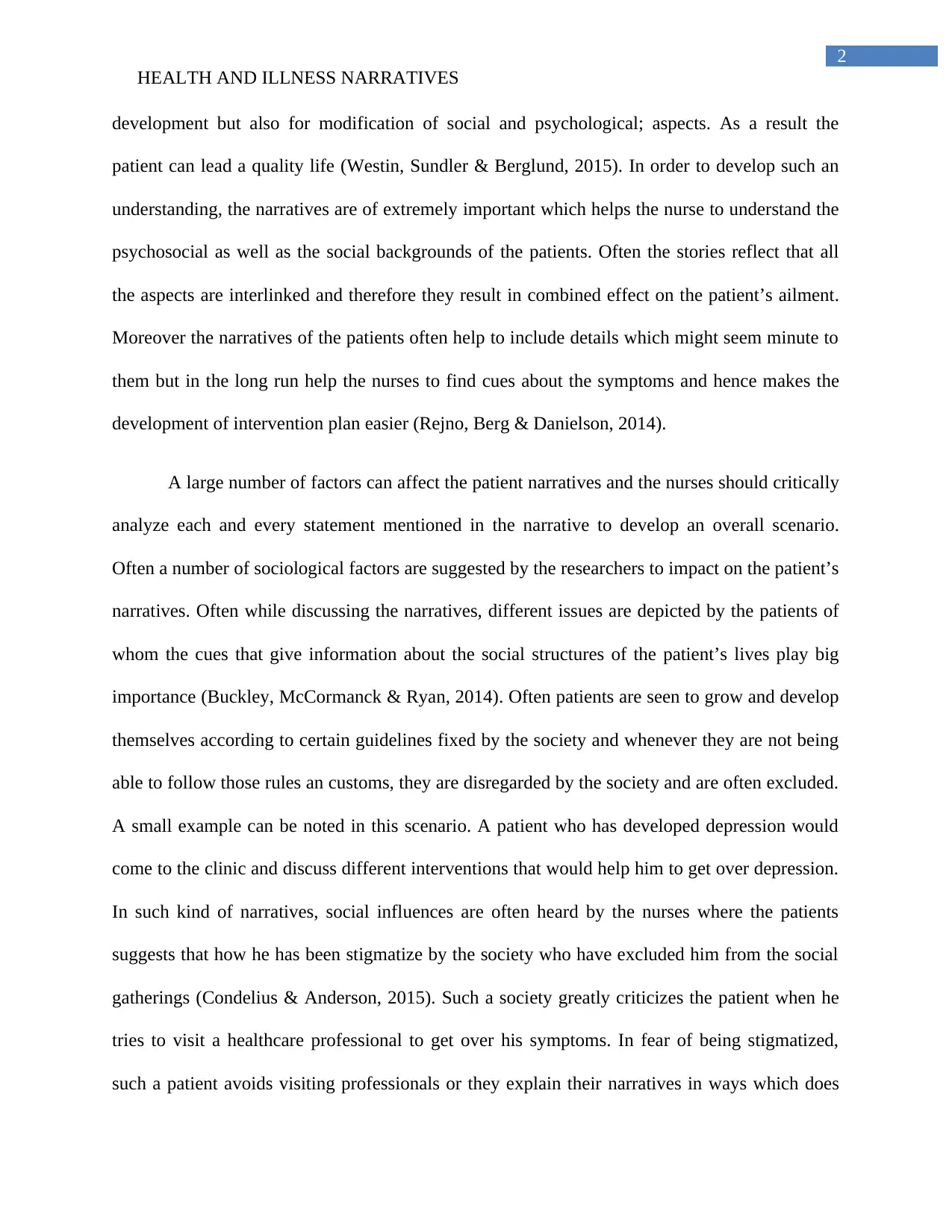
2
HEALTH AND ILLNESS NARRATIVES
development but also for modification of social and psychological; aspects. As a result the
patient can lead a quality life (Westin, Sundler & Berglund, 2015). In order to develop such an
understanding, the narratives are of extremely important which helps the nurse to understand the
psychosocial as well as the social backgrounds of the patients. Often the stories reflect that all
the aspects are interlinked and therefore they result in combined effect on the patient’s ailment.
Moreover the narratives of the patients often help to include details which might seem minute to
them but in the long run help the nurses to find cues about the symptoms and hence makes the
development of intervention plan easier (Rejno, Berg & Danielson, 2014).
A large number of factors can affect the patient narratives and the nurses should critically
analyze each and every statement mentioned in the narrative to develop an overall scenario.
Often a number of sociological factors are suggested by the researchers to impact on the patient’s
narratives. Often while discussing the narratives, different issues are depicted by the patients of
whom the cues that give information about the social structures of the patient’s lives play big
importance (Buckley, McCormanck & Ryan, 2014). Often patients are seen to grow and develop
themselves according to certain guidelines fixed by the society and whenever they are not being
able to follow those rules an customs, they are disregarded by the society and are often excluded.
A small example can be noted in this scenario. A patient who has developed depression would
come to the clinic and discuss different interventions that would help him to get over depression.
In such kind of narratives, social influences are often heard by the nurses where the patients
suggests that how he has been stigmatize by the society who have excluded him from the social
gatherings (Condelius & Anderson, 2015). Such a society greatly criticizes the patient when he
tries to visit a healthcare professional to get over his symptoms. In fear of being stigmatized,
such a patient avoids visiting professionals or they explain their narratives in ways which does
HEALTH AND ILLNESS NARRATIVES
development but also for modification of social and psychological; aspects. As a result the
patient can lead a quality life (Westin, Sundler & Berglund, 2015). In order to develop such an
understanding, the narratives are of extremely important which helps the nurse to understand the
psychosocial as well as the social backgrounds of the patients. Often the stories reflect that all
the aspects are interlinked and therefore they result in combined effect on the patient’s ailment.
Moreover the narratives of the patients often help to include details which might seem minute to
them but in the long run help the nurses to find cues about the symptoms and hence makes the
development of intervention plan easier (Rejno, Berg & Danielson, 2014).
A large number of factors can affect the patient narratives and the nurses should critically
analyze each and every statement mentioned in the narrative to develop an overall scenario.
Often a number of sociological factors are suggested by the researchers to impact on the patient’s
narratives. Often while discussing the narratives, different issues are depicted by the patients of
whom the cues that give information about the social structures of the patient’s lives play big
importance (Buckley, McCormanck & Ryan, 2014). Often patients are seen to grow and develop
themselves according to certain guidelines fixed by the society and whenever they are not being
able to follow those rules an customs, they are disregarded by the society and are often excluded.
A small example can be noted in this scenario. A patient who has developed depression would
come to the clinic and discuss different interventions that would help him to get over depression.
In such kind of narratives, social influences are often heard by the nurses where the patients
suggests that how he has been stigmatize by the society who have excluded him from the social
gatherings (Condelius & Anderson, 2015). Such a society greatly criticizes the patient when he
tries to visit a healthcare professional to get over his symptoms. In fear of being stigmatized,
such a patient avoids visiting professionals or they explain their narratives in ways which does
⊘ This is a preview!⊘
Do you want full access?
Subscribe today to unlock all pages.

Trusted by 1+ million students worldwide
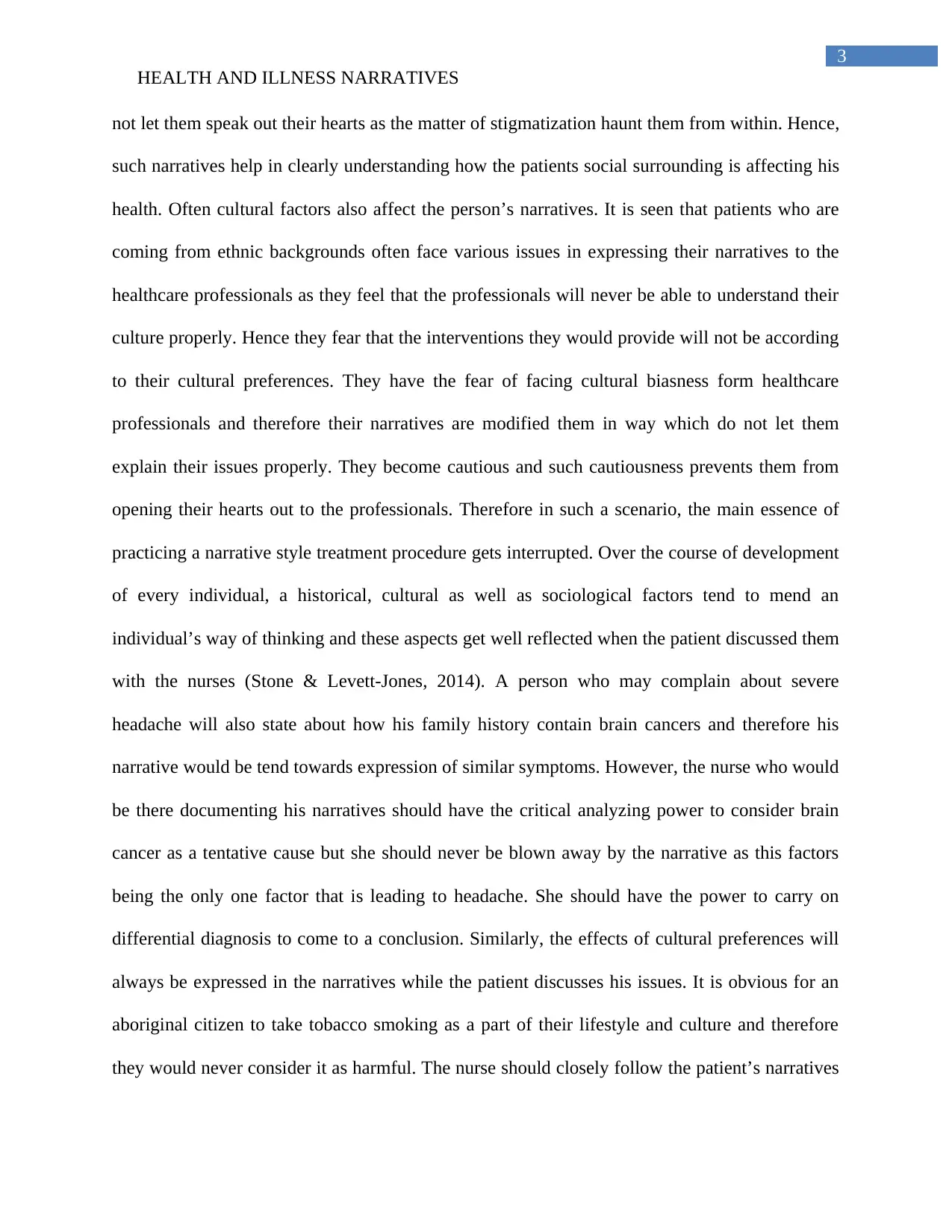
3
HEALTH AND ILLNESS NARRATIVES
not let them speak out their hearts as the matter of stigmatization haunt them from within. Hence,
such narratives help in clearly understanding how the patients social surrounding is affecting his
health. Often cultural factors also affect the person’s narratives. It is seen that patients who are
coming from ethnic backgrounds often face various issues in expressing their narratives to the
healthcare professionals as they feel that the professionals will never be able to understand their
culture properly. Hence they fear that the interventions they would provide will not be according
to their cultural preferences. They have the fear of facing cultural biasness form healthcare
professionals and therefore their narratives are modified them in way which do not let them
explain their issues properly. They become cautious and such cautiousness prevents them from
opening their hearts out to the professionals. Therefore in such a scenario, the main essence of
practicing a narrative style treatment procedure gets interrupted. Over the course of development
of every individual, a historical, cultural as well as sociological factors tend to mend an
individual’s way of thinking and these aspects get well reflected when the patient discussed them
with the nurses (Stone & Levett-Jones, 2014). A person who may complain about severe
headache will also state about how his family history contain brain cancers and therefore his
narrative would be tend towards expression of similar symptoms. However, the nurse who would
be there documenting his narratives should have the critical analyzing power to consider brain
cancer as a tentative cause but she should never be blown away by the narrative as this factors
being the only one factor that is leading to headache. She should have the power to carry on
differential diagnosis to come to a conclusion. Similarly, the effects of cultural preferences will
always be expressed in the narratives while the patient discusses his issues. It is obvious for an
aboriginal citizen to take tobacco smoking as a part of their lifestyle and culture and therefore
they would never consider it as harmful. The nurse should closely follow the patient’s narratives
HEALTH AND ILLNESS NARRATIVES
not let them speak out their hearts as the matter of stigmatization haunt them from within. Hence,
such narratives help in clearly understanding how the patients social surrounding is affecting his
health. Often cultural factors also affect the person’s narratives. It is seen that patients who are
coming from ethnic backgrounds often face various issues in expressing their narratives to the
healthcare professionals as they feel that the professionals will never be able to understand their
culture properly. Hence they fear that the interventions they would provide will not be according
to their cultural preferences. They have the fear of facing cultural biasness form healthcare
professionals and therefore their narratives are modified them in way which do not let them
explain their issues properly. They become cautious and such cautiousness prevents them from
opening their hearts out to the professionals. Therefore in such a scenario, the main essence of
practicing a narrative style treatment procedure gets interrupted. Over the course of development
of every individual, a historical, cultural as well as sociological factors tend to mend an
individual’s way of thinking and these aspects get well reflected when the patient discussed them
with the nurses (Stone & Levett-Jones, 2014). A person who may complain about severe
headache will also state about how his family history contain brain cancers and therefore his
narrative would be tend towards expression of similar symptoms. However, the nurse who would
be there documenting his narratives should have the critical analyzing power to consider brain
cancer as a tentative cause but she should never be blown away by the narrative as this factors
being the only one factor that is leading to headache. She should have the power to carry on
differential diagnosis to come to a conclusion. Similarly, the effects of cultural preferences will
always be expressed in the narratives while the patient discusses his issues. It is obvious for an
aboriginal citizen to take tobacco smoking as a part of their lifestyle and culture and therefore
they would never consider it as harmful. The nurse should closely follow the patient’s narratives
Paraphrase This Document
Need a fresh take? Get an instant paraphrase of this document with our AI Paraphraser
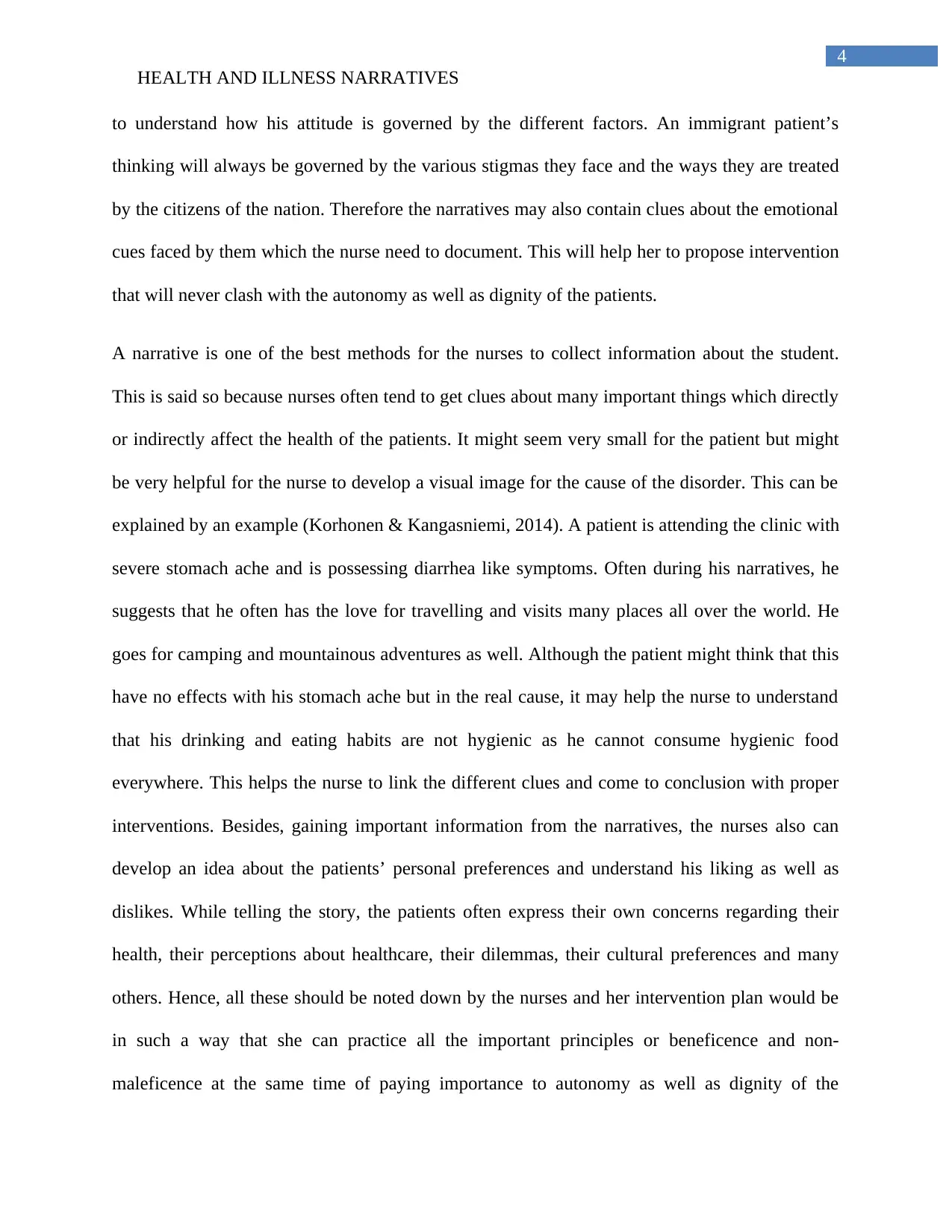
4
HEALTH AND ILLNESS NARRATIVES
to understand how his attitude is governed by the different factors. An immigrant patient’s
thinking will always be governed by the various stigmas they face and the ways they are treated
by the citizens of the nation. Therefore the narratives may also contain clues about the emotional
cues faced by them which the nurse need to document. This will help her to propose intervention
that will never clash with the autonomy as well as dignity of the patients.
A narrative is one of the best methods for the nurses to collect information about the student.
This is said so because nurses often tend to get clues about many important things which directly
or indirectly affect the health of the patients. It might seem very small for the patient but might
be very helpful for the nurse to develop a visual image for the cause of the disorder. This can be
explained by an example (Korhonen & Kangasniemi, 2014). A patient is attending the clinic with
severe stomach ache and is possessing diarrhea like symptoms. Often during his narratives, he
suggests that he often has the love for travelling and visits many places all over the world. He
goes for camping and mountainous adventures as well. Although the patient might think that this
have no effects with his stomach ache but in the real cause, it may help the nurse to understand
that his drinking and eating habits are not hygienic as he cannot consume hygienic food
everywhere. This helps the nurse to link the different clues and come to conclusion with proper
interventions. Besides, gaining important information from the narratives, the nurses also can
develop an idea about the patients’ personal preferences and understand his liking as well as
dislikes. While telling the story, the patients often express their own concerns regarding their
health, their perceptions about healthcare, their dilemmas, their cultural preferences and many
others. Hence, all these should be noted down by the nurses and her intervention plan would be
in such a way that she can practice all the important principles or beneficence and non-
maleficence at the same time of paying importance to autonomy as well as dignity of the
HEALTH AND ILLNESS NARRATIVES
to understand how his attitude is governed by the different factors. An immigrant patient’s
thinking will always be governed by the various stigmas they face and the ways they are treated
by the citizens of the nation. Therefore the narratives may also contain clues about the emotional
cues faced by them which the nurse need to document. This will help her to propose intervention
that will never clash with the autonomy as well as dignity of the patients.
A narrative is one of the best methods for the nurses to collect information about the student.
This is said so because nurses often tend to get clues about many important things which directly
or indirectly affect the health of the patients. It might seem very small for the patient but might
be very helpful for the nurse to develop a visual image for the cause of the disorder. This can be
explained by an example (Korhonen & Kangasniemi, 2014). A patient is attending the clinic with
severe stomach ache and is possessing diarrhea like symptoms. Often during his narratives, he
suggests that he often has the love for travelling and visits many places all over the world. He
goes for camping and mountainous adventures as well. Although the patient might think that this
have no effects with his stomach ache but in the real cause, it may help the nurse to understand
that his drinking and eating habits are not hygienic as he cannot consume hygienic food
everywhere. This helps the nurse to link the different clues and come to conclusion with proper
interventions. Besides, gaining important information from the narratives, the nurses also can
develop an idea about the patients’ personal preferences and understand his liking as well as
dislikes. While telling the story, the patients often express their own concerns regarding their
health, their perceptions about healthcare, their dilemmas, their cultural preferences and many
others. Hence, all these should be noted down by the nurses and her intervention plan would be
in such a way that she can practice all the important principles or beneficence and non-
maleficence at the same time of paying importance to autonomy as well as dignity of the
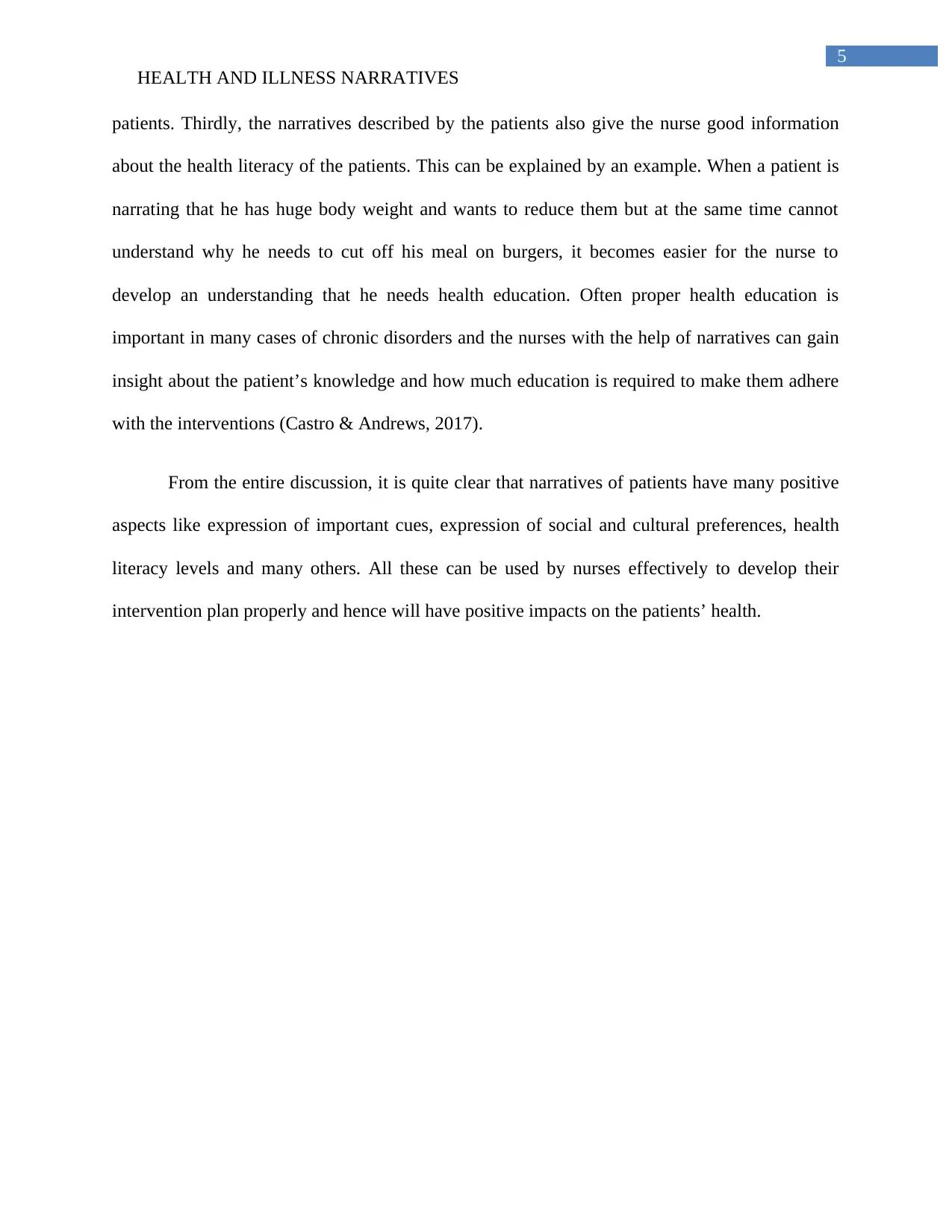
5
HEALTH AND ILLNESS NARRATIVES
patients. Thirdly, the narratives described by the patients also give the nurse good information
about the health literacy of the patients. This can be explained by an example. When a patient is
narrating that he has huge body weight and wants to reduce them but at the same time cannot
understand why he needs to cut off his meal on burgers, it becomes easier for the nurse to
develop an understanding that he needs health education. Often proper health education is
important in many cases of chronic disorders and the nurses with the help of narratives can gain
insight about the patient’s knowledge and how much education is required to make them adhere
with the interventions (Castro & Andrews, 2017).
From the entire discussion, it is quite clear that narratives of patients have many positive
aspects like expression of important cues, expression of social and cultural preferences, health
literacy levels and many others. All these can be used by nurses effectively to develop their
intervention plan properly and hence will have positive impacts on the patients’ health.
HEALTH AND ILLNESS NARRATIVES
patients. Thirdly, the narratives described by the patients also give the nurse good information
about the health literacy of the patients. This can be explained by an example. When a patient is
narrating that he has huge body weight and wants to reduce them but at the same time cannot
understand why he needs to cut off his meal on burgers, it becomes easier for the nurse to
develop an understanding that he needs health education. Often proper health education is
important in many cases of chronic disorders and the nurses with the help of narratives can gain
insight about the patient’s knowledge and how much education is required to make them adhere
with the interventions (Castro & Andrews, 2017).
From the entire discussion, it is quite clear that narratives of patients have many positive
aspects like expression of important cues, expression of social and cultural preferences, health
literacy levels and many others. All these can be used by nurses effectively to develop their
intervention plan properly and hence will have positive impacts on the patients’ health.
⊘ This is a preview!⊘
Do you want full access?
Subscribe today to unlock all pages.

Trusted by 1+ million students worldwide
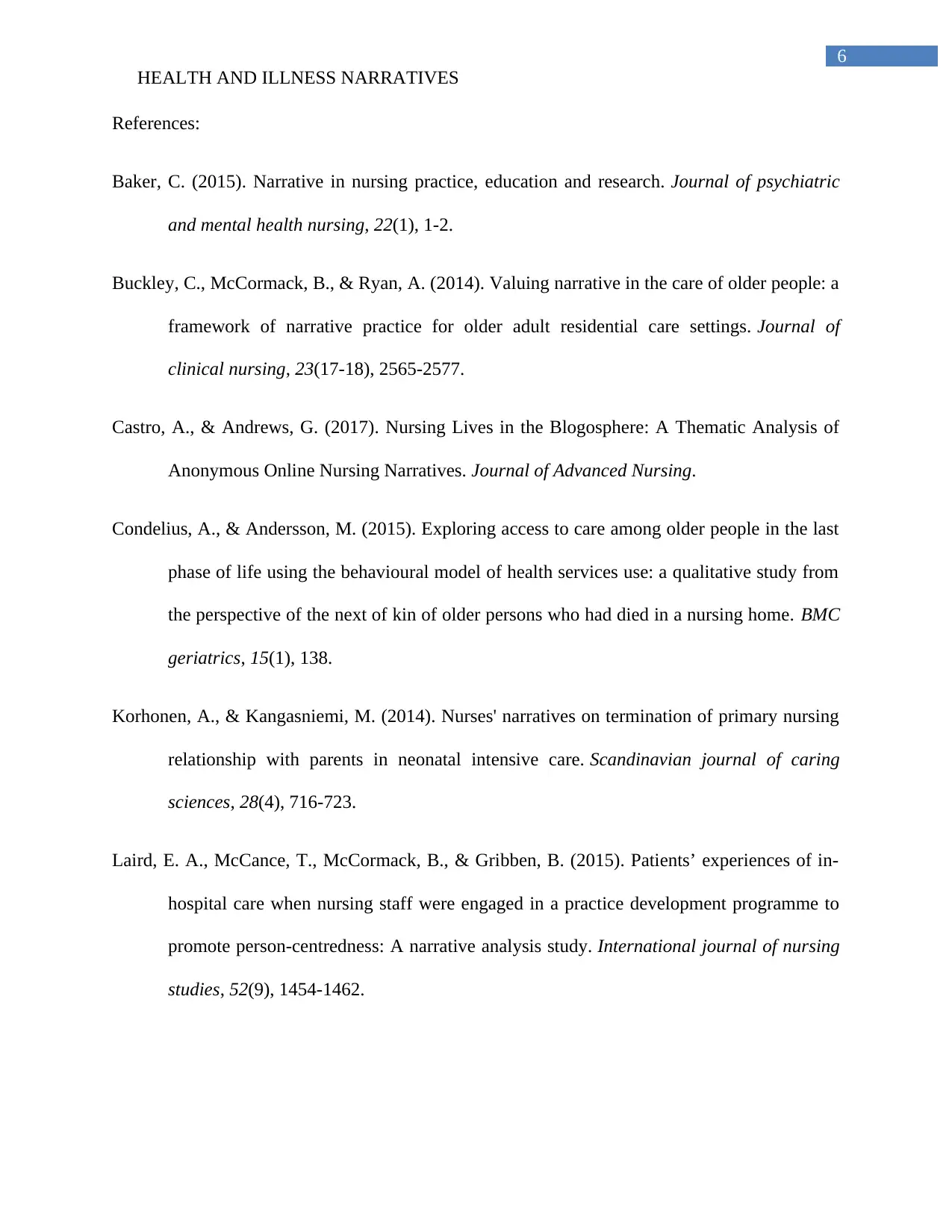
6
HEALTH AND ILLNESS NARRATIVES
References:
Baker, C. (2015). Narrative in nursing practice, education and research. Journal of psychiatric
and mental health nursing, 22(1), 1-2.
Buckley, C., McCormack, B., & Ryan, A. (2014). Valuing narrative in the care of older people: a
framework of narrative practice for older adult residential care settings. Journal of
clinical nursing, 23(17-18), 2565-2577.
Castro, A., & Andrews, G. (2017). Nursing Lives in the Blogosphere: A Thematic Analysis of
Anonymous Online Nursing Narratives. Journal of Advanced Nursing.
Condelius, A., & Andersson, M. (2015). Exploring access to care among older people in the last
phase of life using the behavioural model of health services use: a qualitative study from
the perspective of the next of kin of older persons who had died in a nursing home. BMC
geriatrics, 15(1), 138.
Korhonen, A., & Kangasniemi, M. (2014). Nurses' narratives on termination of primary nursing
relationship with parents in neonatal intensive care. Scandinavian journal of caring
sciences, 28(4), 716-723.
Laird, E. A., McCance, T., McCormack, B., & Gribben, B. (2015). Patients’ experiences of in-
hospital care when nursing staff were engaged in a practice development programme to
promote person-centredness: A narrative analysis study. International journal of nursing
studies, 52(9), 1454-1462.
HEALTH AND ILLNESS NARRATIVES
References:
Baker, C. (2015). Narrative in nursing practice, education and research. Journal of psychiatric
and mental health nursing, 22(1), 1-2.
Buckley, C., McCormack, B., & Ryan, A. (2014). Valuing narrative in the care of older people: a
framework of narrative practice for older adult residential care settings. Journal of
clinical nursing, 23(17-18), 2565-2577.
Castro, A., & Andrews, G. (2017). Nursing Lives in the Blogosphere: A Thematic Analysis of
Anonymous Online Nursing Narratives. Journal of Advanced Nursing.
Condelius, A., & Andersson, M. (2015). Exploring access to care among older people in the last
phase of life using the behavioural model of health services use: a qualitative study from
the perspective of the next of kin of older persons who had died in a nursing home. BMC
geriatrics, 15(1), 138.
Korhonen, A., & Kangasniemi, M. (2014). Nurses' narratives on termination of primary nursing
relationship with parents in neonatal intensive care. Scandinavian journal of caring
sciences, 28(4), 716-723.
Laird, E. A., McCance, T., McCormack, B., & Gribben, B. (2015). Patients’ experiences of in-
hospital care when nursing staff were engaged in a practice development programme to
promote person-centredness: A narrative analysis study. International journal of nursing
studies, 52(9), 1454-1462.
Paraphrase This Document
Need a fresh take? Get an instant paraphrase of this document with our AI Paraphraser
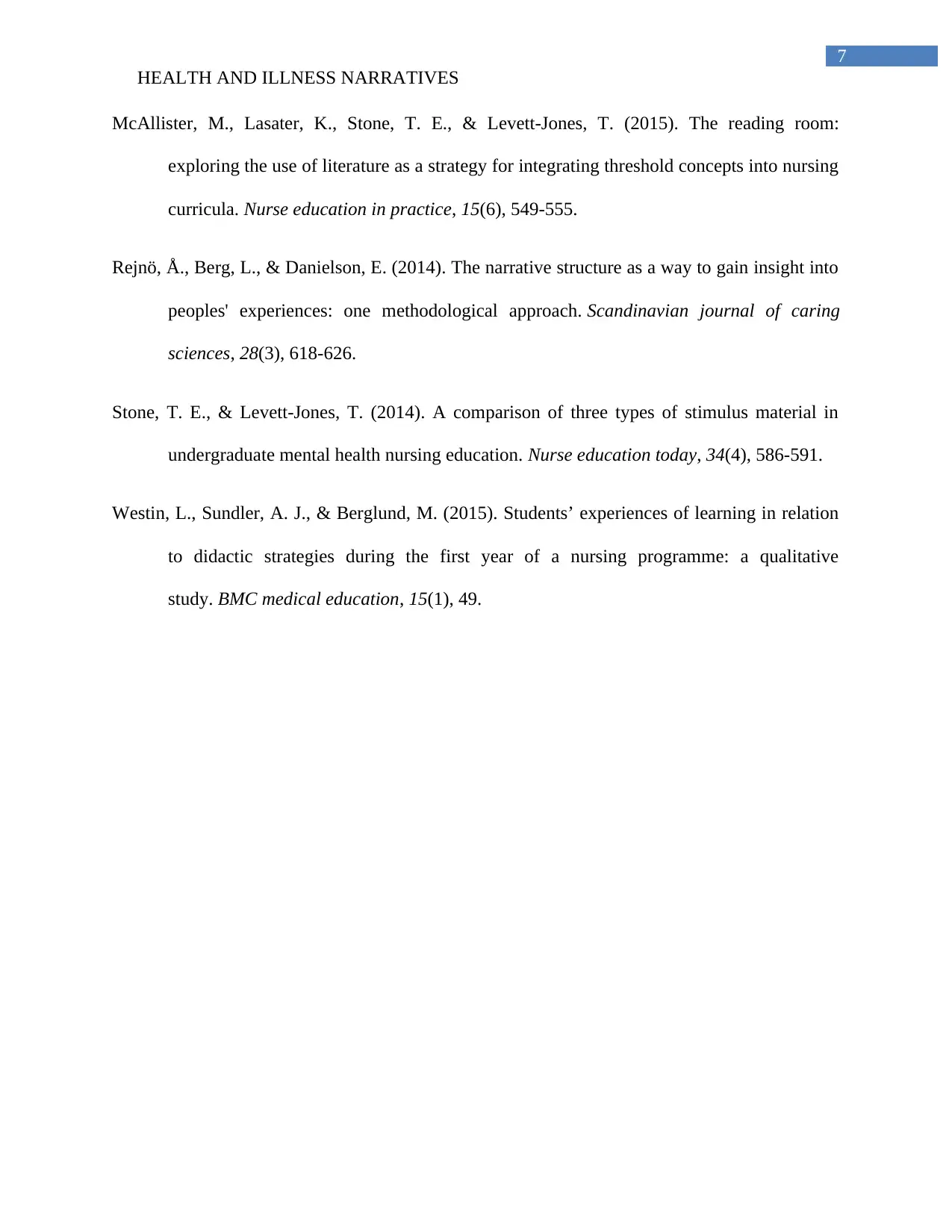
7
HEALTH AND ILLNESS NARRATIVES
McAllister, M., Lasater, K., Stone, T. E., & Levett-Jones, T. (2015). The reading room:
exploring the use of literature as a strategy for integrating threshold concepts into nursing
curricula. Nurse education in practice, 15(6), 549-555.
Rejnö, Å., Berg, L., & Danielson, E. (2014). The narrative structure as a way to gain insight into
peoples' experiences: one methodological approach. Scandinavian journal of caring
sciences, 28(3), 618-626.
Stone, T. E., & Levett-Jones, T. (2014). A comparison of three types of stimulus material in
undergraduate mental health nursing education. Nurse education today, 34(4), 586-591.
Westin, L., Sundler, A. J., & Berglund, M. (2015). Students’ experiences of learning in relation
to didactic strategies during the first year of a nursing programme: a qualitative
study. BMC medical education, 15(1), 49.
HEALTH AND ILLNESS NARRATIVES
McAllister, M., Lasater, K., Stone, T. E., & Levett-Jones, T. (2015). The reading room:
exploring the use of literature as a strategy for integrating threshold concepts into nursing
curricula. Nurse education in practice, 15(6), 549-555.
Rejnö, Å., Berg, L., & Danielson, E. (2014). The narrative structure as a way to gain insight into
peoples' experiences: one methodological approach. Scandinavian journal of caring
sciences, 28(3), 618-626.
Stone, T. E., & Levett-Jones, T. (2014). A comparison of three types of stimulus material in
undergraduate mental health nursing education. Nurse education today, 34(4), 586-591.
Westin, L., Sundler, A. J., & Berglund, M. (2015). Students’ experiences of learning in relation
to didactic strategies during the first year of a nursing programme: a qualitative
study. BMC medical education, 15(1), 49.
1 out of 8
Related Documents
Your All-in-One AI-Powered Toolkit for Academic Success.
+13062052269
info@desklib.com
Available 24*7 on WhatsApp / Email
![[object Object]](/_next/static/media/star-bottom.7253800d.svg)
Unlock your academic potential
Copyright © 2020–2025 A2Z Services. All Rights Reserved. Developed and managed by ZUCOL.





